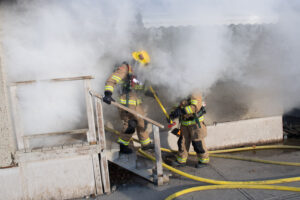
Steve Dongworth
Chief, Calgary Fire Department and CFAI Chair
One thing as leaders that we rarely talk, or even think, about are leadership traits. These are the things that make people want to follow you, an essential component of leadership. As a leader, you should look behind you often, because if no one is following you, you aren’t leading. The traits that you display will also be the key to inspiring and motivating others as well as convincing those around you that they can trust you. A good thing to remember is that people are always watching you and they will decide whether to follow you based on what they see.
None of this is to say that technical or strategic competency is not important. Management competence, strategic thinking, political acumen and vision are all vital. These technical skills are easier to learn whereas, to a large degree, leadership traits are intrinsic. If you don’t possess these it will be tough to acquire them. And people around you will notice right away if you are trying to fake it – we get to lead smart people! What we can do is develop those traits and find ways to let other people know who we are.

Trust will largely be based on the consistency people around you see between your actions and your words. If trust is not present everything else that you do will be very much more challenging.
Trust is at the heart of leadership and is absolutely key in relationships with employees, peers, administrators, politicians, external stakeholder agencies and your community. Trust is also two-way, it is about garnering trust while at the same time extending trust to those around us. Trust will largely be based on the consistency people around you see between your actions and your words. If trust is not present, everything else that you do will be very much more challenging.
Demonstrating humility and showing vulnerability are two traits that are based on your ability to admit when you have made a mistake, apologizing where necessary and learning from the experience to ensure that you don’t repeat the same mistake. It is also about acknowledging that you don’t always have all the answers and want to hear from others to add value to your decision. Beware of the escalation of commitment that occurs when we know we are headed in the wrong direction, but we actually close our minds and push harder in the wrong direction.
Building connections with those around us is key. Take time to celebrate with people at the happy times such as promotions, graduations, retirements and the birth of children. However also be there as they go through difficult times like the death of loved ones, psychological or emotional struggles as well as physical injuries or illness. This is a trait where if it doesn’t come naturally to you it will be difficult to do, and if it’s not from the heart, people will figure it out quickly.
Effective communication is always a key factor in success and when displaying leadership traits it becomes essential. In fact, in larger organizations the only way people may learn more about you is through remote communication, whether through video messages, email, phone, blogs or live streamed meetings or hopefully a combination of all of these. Beware of overmanaged, overpolished, sanitized or depersonalized communications as people will know immediately if they can see you speaking those words, and if they can’t see your words they may disregard as propaganda or spun communication. I have the greatest respect for the communicators I work with, and they grow to learn your individual style over time. Red ink is a good thing in the editing process!
Create a culture of recognition in your organization. Find people doing things right and recognize them. Firefighters can be the least comfortable with recognition, even after extraordinary work, which means that the recognition has to be appropriate to the group, heartfelt and meaningful. How often do we hear, even after life-saving interventions, that they were “just doing their jobs” or “any one of us would have done the same thing.” And it doesn’t have to look like gift cards, points in a corporate recognition program or movie tickets. A visit from the leader in the workplace with their peers over coffee, a thank you, words of recognition, and a handshake goes a long way. And when you create this culture of recognition you get to hear more about the amazing work our people do, and they strive to do more of it.
Probably the toughest part of being a leader is making tough decisions, and this is when we have to demonstrate courage to follow the right path and pursue often difficult, and unpopular, directions. This is an element that really sorts out great leaders from the rest. The greatest example right now, outside of the work on the physical and psychological health of firefighters, is the transformation of the culture in our workplace. There is much that must be done around behaviour in our workplaces, particularly as it relates to people from underrepresented and marginalized demographics, who many don’t see as fitting the traditional firefighter stereotype. Suggesting that anything is wrong, and even worse suggesting that something has to change, is a sure way to create a storm in that sea that can intimidate any leader. But some things are wrong, and some things within our fire service culture, that ironically promotes doing so much for our customer, and also even more ironically has a core belief that we take care of each other as a priority, need to change.

Find people doing things right and recognize them.
I started this brief journey through the leadership traits with a keystone element and will end in the same manner. Earning and showing respect is fundamental in leading emergency services organizations. And you can’t just do one and not the other. If you don’t show respect you will never earn respect. Respect will be key when you are acting as a change-agent in your organization and cannot be commanded. It is earned by actions as well as words, but only when they align with your actions.A strong set of values, communicated through a shared culture, allows you to lead through influence, not control.
Modeling behaviours, communicating with your people, creating a culture of recognition for work that supports the culture and goes above and beyond – all of these seemingly small acts will influence others in your organization to follow your lead. Using the connections and communication you establish with people in your organization to your advantage means that you can guide people through influence and persuasion, rather than force. Studies show that performance is increased when people receive positive reinforcement about their abilities, and that knowing their work helps others may help to increase unconscious motivation.
| Seven Fundamentals of Leadership |
|
You must be humble and connected to others in your organization to make being open-minded and forward-thinking possible across the organization. If they trust you and you trust them, if they respect you and you respect them, and you model a positive set of values that guide the growth of your organization, it is much less likely you’ll have to lay down the law to get work done or to get people “in line.”

The only way to make a difference through public service is by empowering, inspiring and supporting those who work with the citizens and removing barriers that prevent them from doing their best.
If you came here looking for something you haven’t heard before you may be disappointed. In fact many of you will have heard the same things in seminars, courses and articles such as this through the years. The problem is that this does not always translate into behavioural change. For many of us getting into senior positions we feel pretty good about it, as we should, however often we get to thinking we are really important, and sometimes the most important person in the organization, and special while also forgetting what we have learnt and where we came from. Quickly we can become very enamored with the power of the position, we can get to feeling very entitled to a much greater degree than those that work with us, and very quickly the power can corrupt us and lead us into some bad places. We can quickly come to believe that we are untouchable. (Good intentions – authority – power – entitlement – privilege – untouchable – corruption). There is much we can leverage when we become a leader and it is for each of us to choose what is important to us. We are responsible to inspire our people, we have to recognize that it is our front line people who touch the customer daily who are the most important and all we really can do is support them as best we can in doing this.
So, in closing, the only way to make a difference through public service is by empowering, inspiring and supporting those who work with the citizens and removing barriers that prevent them from doing their best.
Steve Dongworth is fire chief for the Calgary Fire Department, a CFAI accredited agency. He joined the department in 1992 and has held the positions of deputy chief of Community Standards, Recruitment and Training; Operations; Community Services; Administration; and Emergency Management.
Chief Dongworth has completed a number of university-level management certificate programs in health and safety; general management and strategic management and has received a Masters Certificate in Municipal Learning.
